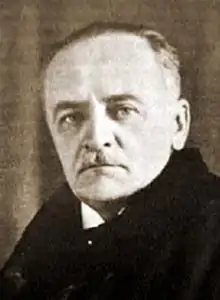Bohdan Lepky
Bohdan Teodor Nestor Lepky, (Ukrainian: Богдан Теодор Нестор Лепкий, 4 November 1872 – 21 July 1941) was a Ukrainian writer, poet, scholar, public figure, and artist.[1]
Bohdan Lepky | |
|---|---|
Богдан Лепкий | |
 | |
| Born | 9 November 1872 |
| Died | 21 July 1941 |
| Burial place | Rakowicki Cemetery |
| Nationality | Ukrainian |
He was born on November 9, 1872, in the village of Krohulets, in the same house where the Polish insurgent[2] Bogdan Jarocki once lived.
Education
Bohdan was sent to an ordinary school in Berezhany at the age of six, where he started in the second grade. He later attended grammar school at the same town. Lepky would later recall that most young Ukrainian and Polish students were noted for their ethnic tolerance, mutual respect, openness, and active participation in choirs, stage productions, and concerts with a repertoire of both Polish and Ukrainian productions.
After completing grammar school in 1891, Lepky was admitted to the Academy of Arts in Vienna but soon realized that literature was his vocation. He then studied at Lviv University, graduated in 1895, and returned to grammar school in Berezhany as a teacher of Ukrainian and German language and literature.
Years in Kraków
The writer's "Polish period" began in 1899, when Kraków's Jagiellonian University launched a series of lectures on the Ukrainian language and literature and offered a chair to Lepky, who remained there for the rest of his life.
For Kraków's Ukrainian community, Lepky's house at 28, Ulica Zielona. was a cultural hub where one could encounter many figures of Ukrainian scholarship and culture, including Kyrylo Studynsky, Vasyl Stefanyk, Vyacheslav Lypynsky, Mykhailo Zhuk, Mykhailo Boychuk, and others. Lepky also maintained a creative dialogue with Polish artists such as Kazimierz Tetmajer (1865–1940; a poet and prose writer, and author of the historical novel Legend of the Tatra Mountains), the playwright and painter Stanisław Wyspiański, and the poet Władysław Orkan.
Lepky is best known for his Polish translation of the ancient Ukrainian chronicle Słowo o pułku Igora (The Tale of Ihor's Host, 1905) and for the poem "Zhuravli" (Cranes, 1910), known to Ukrainians throughout the world as the mournful song "You see, my brother, my friend, the gray string of cranes flying off into the distance." Lepky said that one of Wyspiański's plays prompted him to compose this poem: "In the fall of 1910, in Kraków, I was walking home after viewing a theatrical production of Wyspianski's drama Noc Listopadowa. The withered leaves rustled beneath my feet, and departing cranes were trumpeting high above. The poem seemed to come by itself, without my knowledge or effort. My brother Lev Lepky set it to music."
Bohdan Lepky died in Kraków and is buried in the local Rakowicki Cemetery.
Literary works
- Cranes (You see, my brother - Ukrainian: Видиш, брате мій)d - 1910 - famous poem known to Ukrainians throughout the world as the song ("You see, my brother, my friend, a gray string of cranes soaring high into the sky...").
- Song lead (Ukrainian: Заспів)
- Mazepa (Ukrainian: Мазепа) - about Ivan Mazepa, Ukrainian hetman
- Away from life, small grief (Ukrainian: Набік життя журбо дрібна)
- I've Lost Contact with You (prose poem) - 1906 - 2
- Nastya (Ukrainian: Настя) - 1897 - 12
- In the Forest (Ukrainian: В лісі)- 1896 - 9
- Revenge (Ukrainian: Помста) - 1901
- Three Portraits - a book of memoirs in which he relates his encounters and creative relationships with Ivan Franko and Vasyl Stefanyk and reminiscences extensively about Władysław Orkan.
- Stricha (Ukrainian: Стріча) - 1899[3]
English Translations
Short story "Why?".[4]
Further reading
References
- Senkus, Roman (1993). "Lepky, Bohdan". Encyclopedia of Ukraine.
- "Lepky, Bohdan". www.encyclopediaofukraine.com. Archived from the original on 15 October 2012. Retrieved 2023-01-20.
- "Стріча - Богдан Лепкий - Тека авторів". Чтиво. Retrieved 2022-10-04.
- Lepky, B. (1998). Brother against Brother. Toronto: Language Lantern Publications. pp. 322–333. Retrieved 2023-01-20.